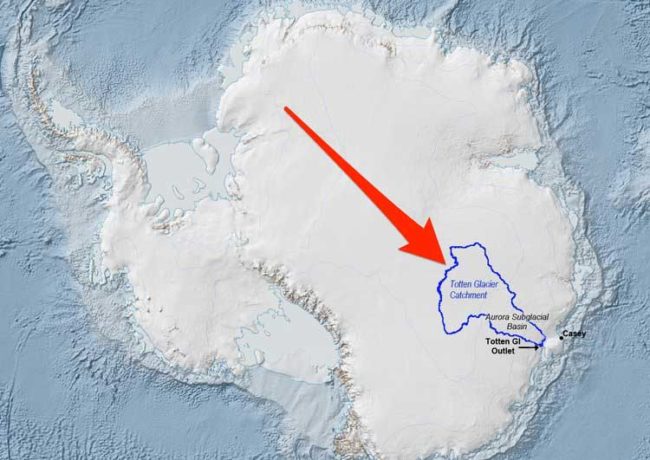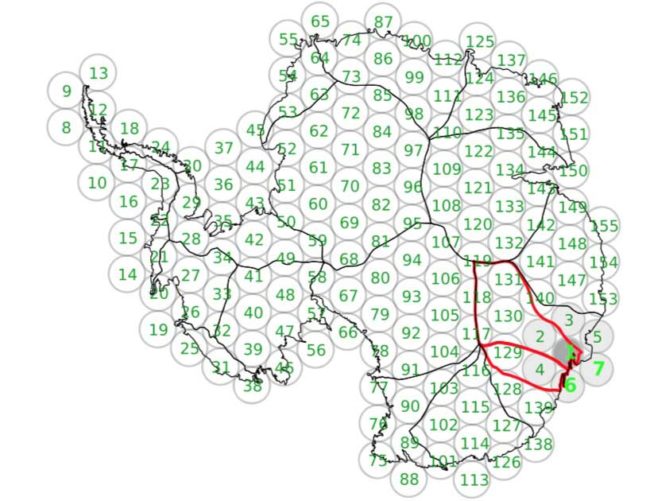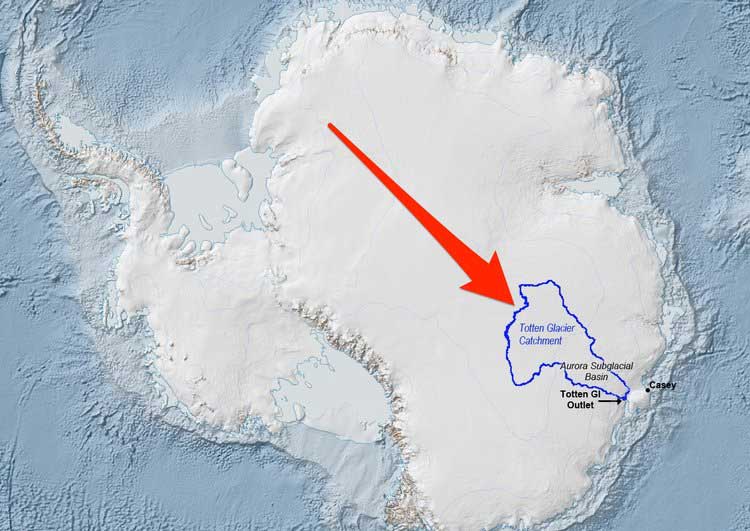 In the East of Antarctica there are two ice sheets named “Totten” and also “Moscow University”. These together contain enough ice to raise sea level by as mush as five meters. There is a new study that has been published that used the Gravity Recovery and Climate Experiment (GRACE) satellites to measure what is currently going on. Spoiler Alert: It’s not good news.
In the East of Antarctica there are two ice sheets named “Totten” and also “Moscow University”. These together contain enough ice to raise sea level by as mush as five meters. There is a new study that has been published that used the Gravity Recovery and Climate Experiment (GRACE) satellites to measure what is currently going on. Spoiler Alert: It’s not good news.
Mass Loss of Totten and Moscow University Glaciers, East Antarctica, Using Regionally Optimized
GRACE Mascons
Published in Geophysical Research Letters, and openly available here, the key information is this …
- There has been a growing concern that warm sea currents that have been observed intruding under the ice sheets in East Antarctica is leading to considerable ice loss.
- Understanding what is happening is very very important – these ice sheets hold enough water to raise sea level by up to five meters – it has global significance.
- To address some of the technical challenges in working out what is going on, they optimised data from the Gravity Recovery and Climate Experiment satellites for the regional scale of the basins that these ice sheets sit in.
- The results they obtained align with other independent estimates of ice loss and so its adds to the growing body of evidence that these glaciers have been rapidly loosing ice for the past 15 years.
Two points …
- It’s an “Oh Shit” moment now that the realisation of what has been suspected is being confirmed. We are more or less committed and on course for many meters of sea level rise as this all unfolds in the coming centuries
- It also adds a new tool that can be used to analyse other regions of Antarctica and resolve uncertainties regarding the ice loss.
What is GRACE measuring?
It’s not one satellite, but instead is a pair (nicknamed “Tom” and “Jerry”) that remain in constance communication.
They use a microwave ranging system to accurately measure changes in the speed and distance between themselves as they fly in a polar orbit about 220 kilometers (140 mi) apart. The accuracy is incredibly fine – The ranging system is sensitive enough to detect separation changes as small as 10 micrometers (approximately one-tenth the width of a human hair) over a distance of 220 kilometers. Every 24 hours they circle the globe 15 times and as they do so, they pickup minute variations in Earth’s gravitational pull. When the first satellite passes over a region of slightly stronger gravity, a gravity anomaly, it is pulled slightly ahead of the trailing satellite. This causes the distance between the satellites to increase. The first spacecraft then passes the anomaly, and slows down again; meanwhile the following spacecraft accelerates, then decelerates over the same point. By measuring the constantly changing distance between the two satellites and combining that data with precise positioning measurements from Global Positioning System (GPS) instruments, it becomes possible to construct a detailed map of Earth’s gravity anomalies.
Glacier ice loss, when large enough, will alter this measurement.
What the new study does is to calibrate these data readings that have been taken over the glaciers over the years of operation for these satellites. (They have been up there taking measurements since 2002). Ice loss means less of a gradational pull, hence the amount of ice loss can be calculated.
What is unique about this study?
It’s not the first to use GRACE data to probe the Totten glacier. For example, in 2009 there was a study that used GRACE data for a forward modeling scheme to estimate the mass balance of Antarctica as the sum of nine uniform areas of large change plus the remaining area of the continent.
What is new here is that this study has employed an optimized regional spherical cap basis to recover a regional time series at the sub-basin level in the Totten/Moscow area.
Literally spherical caps as illustrated below to enable a tighter regional focus …
 … and then captured over time and compared to determine the rate of ice loss.
… and then captured over time and compared to determine the rate of ice loss.
Overall the ice loss from all of Antarctica has tripled in the last 10 years and now exceeds 200 billion tons. If the rate of this ice loss continues, then we are in serious trouble … yet so far we are still quite oblivious in many ways to what is going on.
Further Reading
National Geographic (9th Aug 2018) – We Know West Antarctica Is Melting. Is the East In Danger, Too? ….
In a study published in July, scientists found that the Totten and Moscow University glaciers of East Antarctica—directly south of Australia—lost about 18 billion tons of ice each year between 2002 and 2016. The glaciers sloughed off enough mass every year to cover New Jersey three feet deep in ice.
That’s only about a third of what the West Antarctic glaciers are losing each year. But locked up in the Totten and the smaller neighboring Moscow University glaciers of East Antarctica is enough ice to raise sea levels over 16 feet
Tweets
The journalist and science writer Chris Mooney explains it all in a series of tweets …
1. It's time to talk — again — about Totten glacier, East Antarctica. In size, it’s somewhere between California and Texas. Single-handedly, it could raise global sea levels by nearly 13 feet. They basically don’t get any bigger than this. https://t.co/4w6ctuShhr
— Chris Mooney (@chriscmooney) August 16, 2018
3. We worry a lot about West Antarctica these days. But as a new study notes, if Totten were to go it could raise sea levels more than all glaciers and all the ice in West Antarctica combined. https://t.co/4w6ctuShhr
— Chris Mooney (@chriscmooney) August 16, 2018
5. So changes in the Totten area would be very bad – and we know they are happening. Scientific teams have detected what is essentially an enormous current of warm ocean water flowing towards Totten.
— Chris Mooney (@chriscmooney) August 16, 2018
7. (The water really isn’t actually “warm” according to colloquial understanding – it’s just slightly above the freezing point. But it is salty, which helps the melting process – and the pressure at these extreme depths increases melting even further.)
— Chris Mooney (@chriscmooney) August 16, 2018
9. Their answer, from 2002-2016, is 18.5 billion tons every year. Which is simultaneously a lot – and also not very much.
— Chris Mooney (@chriscmooney) August 16, 2018
11. The Totten region’s loss of 18 billion tons would be a lot for nearly any other glacier (or pair of glaciers) in the world. But for Totten, it’s not that huge. It would take some 20 years for this contribution to amount to a single millimeter of sea level rise.
— Chris Mooney (@chriscmooney) August 16, 2018
13. Recently scientists reported that overall ice losses from Antarctica have tripled in just 10 years; total loss now exceeds 200 billion tons annually. https://t.co/SZWE6UPaCo
— Chris Mooney (@chriscmooney) August 16, 2018
15. In sum, Totten is a place where just a little additional change would be quickly measured in billions of tons of additional ice going into the ocean.
— Chris Mooney (@chriscmooney) August 16, 2018
https://t.co/eTs1ViwJuN’s the epitome of the kind of massive planetary system that we humans, with our greenhouse gas emissions, could blunderingly perturb or destabilize– not even realizing what we’re doing — and then be powerless to stop. /end
— Chris Mooney (@chriscmooney) August 16, 2018
